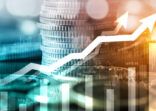“We’re talking to people on the ground and there is a ton of optimism,” said Becker, who has co-managed the firm’s US Small Mid Cap Equity Fund since it launched in late 2014. “CEOs are much more optimistic about capex spending, the prospect for tax reform and the need for infrastructure spending.
“Valuations in the US are high compared to their own history,” he admitted.
“But the picture is more differentiated when you look at yields. The forward earnings yield of stocks relative to the 10 year US Treasury yield or relative to corporate bonds is much more friendly than it used to be.”
Bank optimism
Since the US presidential election last November, the focus has become more sector-specific, with defense, energy and financials priorities. In particular, he likes US bank stocks.
The capital reserve ratio of banks has doubled to 11-12% on average, the same for European banks, since the financial crisis in 2008, when US banks had an average 5-6% tier one capital ratio.
“The underwriting from banks since the crisis has been conservative, meaning very low loan losses are expected.
“The underlying dynamics from bank CEOs is positive. They had regulatory headwinds. With the new administration in the US, the outlook for new regulatory hurdles has completely gone away. Even if they have just status quo, it’s a huge positive for banks.”
European banks, by comparison, are slow in adjusting to bad loans they made.
“In the US, larger banks got their house in order around 2010-11. Deutsche Bank, for example, is out doing another capital raise for $10bn. The European banks are just not dealing with problems fast enough. In Italy, loans don’t get worked out because banks can’t repossess.”
On REITs and utilities he’s generally negative. The concern with both is valuations, which have been driven by bonds and the 10-year treasury yield. “In the US, utility companies have to file for rate increases. It’s a long process and they don’t get a lot of these. Even if their costs rise, [a rate increase] takes a long time.
Utilities valuations are also high. “20-25x earnings for 2% growth doesn’t make sense to us.”
He said the majority of risk is company-specific. In terms of outside risk, he’s watching the elections in France and Germany closely. In the US, the Federal Reserve could make policy missteps and raise rates too aggressively.
The more immediate risk toward the second half is earnings projections. “The market is predicting improvement because of tax reform and infrastructure spending which is not a done deal yet.”
Sticking to the thesis
The fund is fully invested and fairly concentrated with around 50 names, Becker said. The Russell 2500 is the benchmark index and Becker said the managers are “benchmark-aware”.
To find investment ideas, first, sectors are split up among three on the investment team. No sectors are ruled-out. But as part of risk control, the fund has an internal restriction of plus or minus 10% absolute weighting per sector.
After companies are identified in sectors, the team talks to company competitors and does its own financial modelling. “We see where we differ from the perceived wisdom on a stock and build a thesis,” Becker said.
Any new stocks that go in the portfolio are ranked by up- and downside target prices and conviction level – how confident the manager is. They also consider risk contribution to the portfolio.
When new information about a company emerges, for example a new product introduction, the stock price may go up or down. The manager runs the information through the filter of the investment thesis to see if the impact is positive, negative or neutral, he said.
“You have to watch out for `thesis creep’”, Becker said. That’s when a manager’s stock pick is deviating from the thesis but he is tempted to buy more because the price is getting cheaper.
“If new information is working against you, you get out. It doesn’t matter if you gained or lost money, the main idea is sticking to the thesis.”
Performance of the US Small Mid Cap Equity Fund since its launch in October 2014.

Source: FE. Fund NAV has been converted to US dollars for comparative purposes.
















